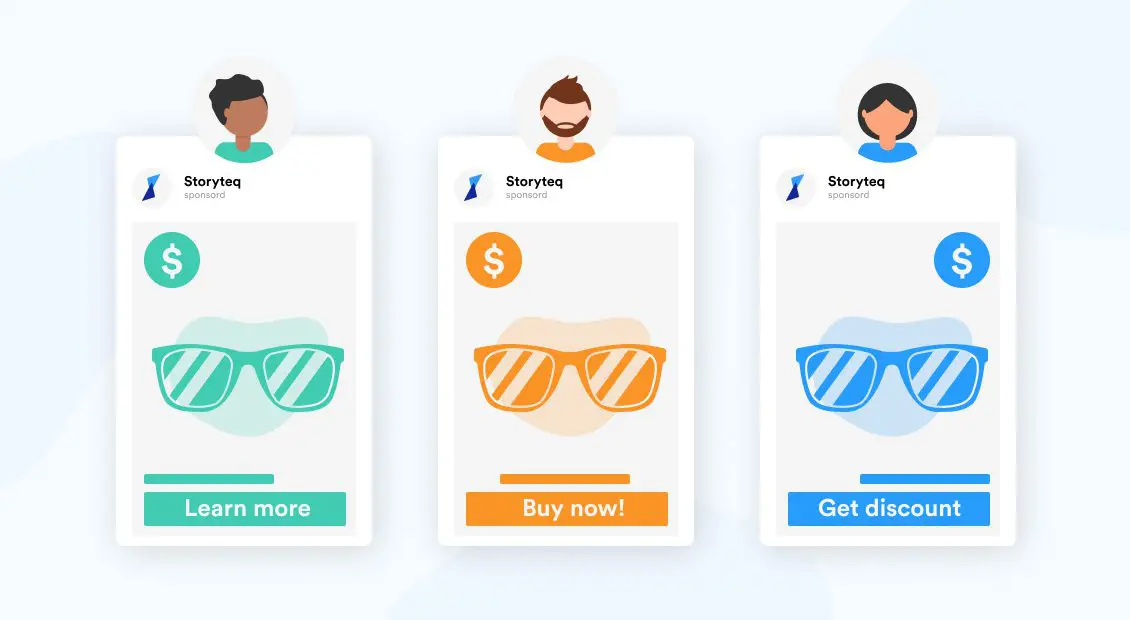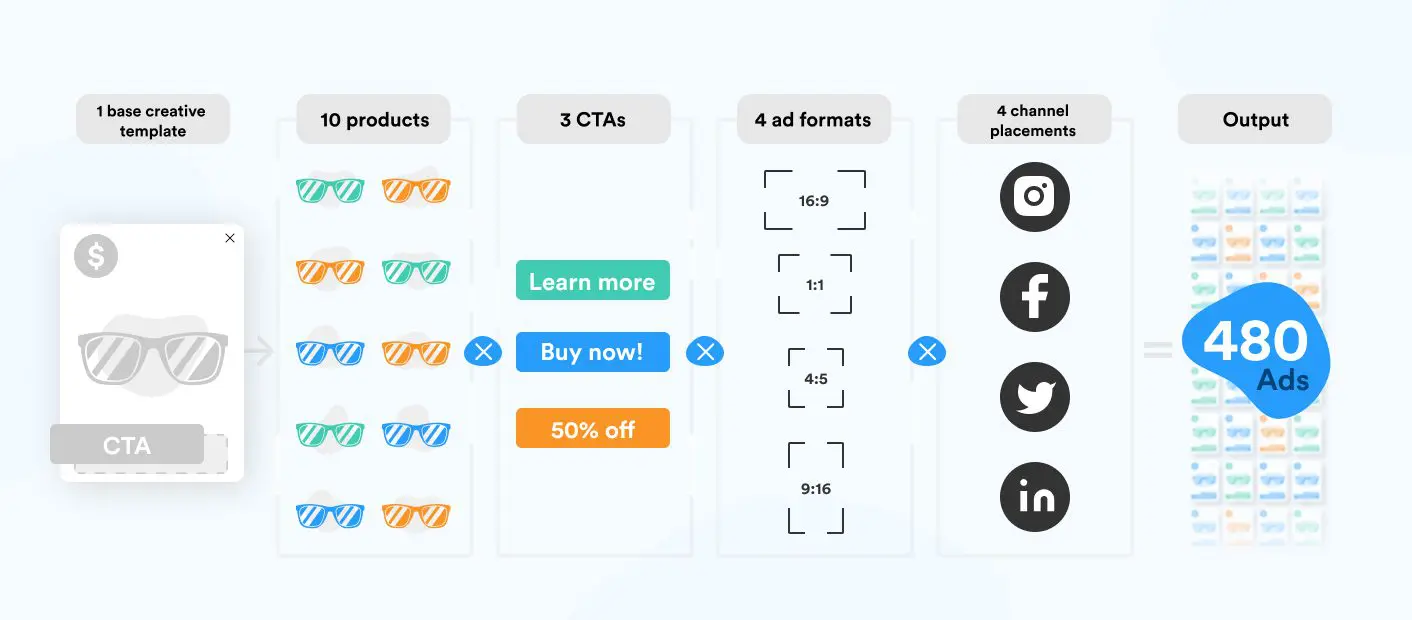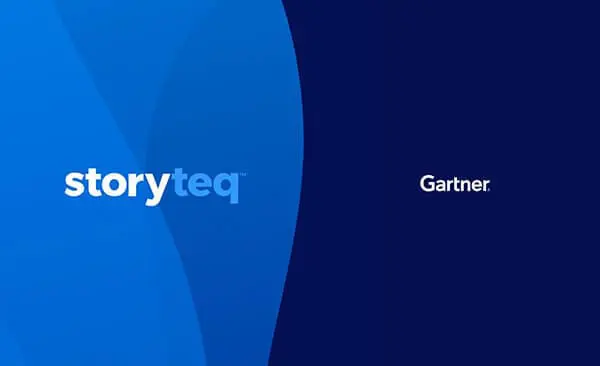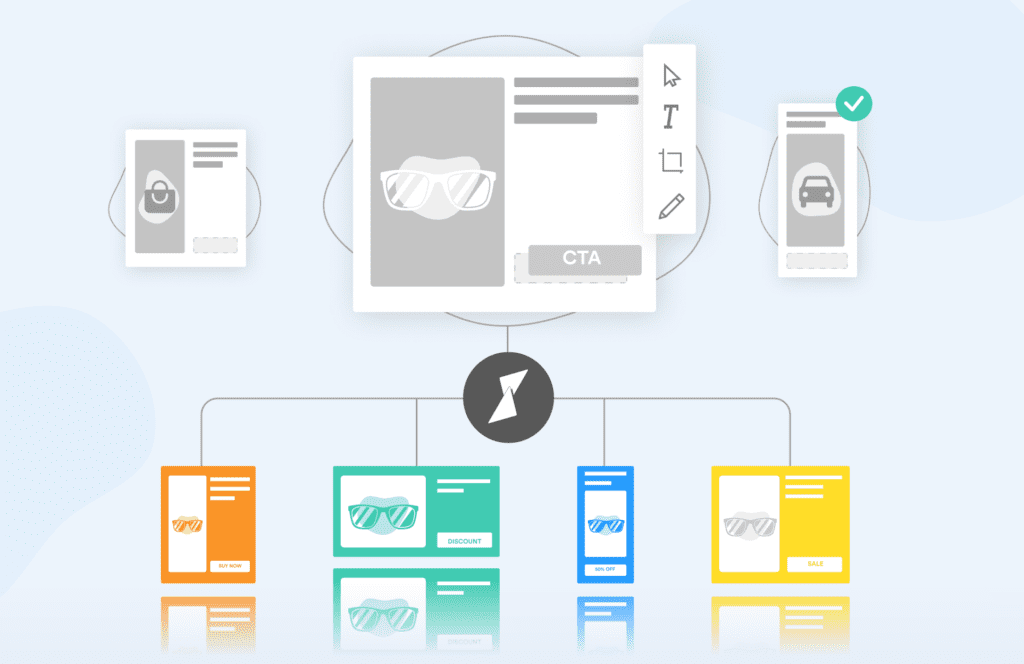Ads are very often the first way your consumers will engage with your brand. So it’s important that your ads speak to them. And when it comes to great ad experiences, dynamic creatives are how you make sure you are telling the right story to the right audience. In this article, we explore what dynamic creatives are and dive into the best practices for getting the most out of them.
We were also curious to learn how marketing teams use dynamic creatives so we sat down with Benjamin David, Digital Marketing Specialist at Heineken, Simon Lejeune, Founder at Mile End Growth and former Head of User Acquisition at Hopper, and Mobashir Ahmad, former Digital Marketer at OYO to get their views on why dynamic creatives are crucial to a modern marketer’s digital ad strategy.
Short on time? Learn what dynamic creatives are:
📖 Dynamic creatives describe the process of creating multiple ad versions through a product feed or a CSV and dynamically assemble elements that compose an ad, including headlines, descriptions, backgrounds, overlay text, CTAs, featured images, etc.
A quick dive into ad personalization
This year alone, we see that ad placement and audience targeting are some of the top optimization tactics used by advertisers. And with good reason.
When you learn how you can connect with your audience, you also know it’s imperative to create unique, personalized ads – and stand out from the competition.
“In today’s world, consumers are bombarded with ads. Online and offline ads are everywhere. It’s a very noisy world so it’s hard to capture your consumers’ attention.”
Benjamin David, Digital Marketing Specialist at Heineken
So it’s not surprising that ad personalization within display advertising has opened up the doors to directly connecting with consumers by using the right ad formats and messaging.
But with more insights and data inputs now needed by marketing teams when making decisions, fresh questions arise like:
- “How do you make sure your ads are on point?”
- “And how can you scale your strategy while keeping your consumers engaged?”
For Benjamin David, Digital Marketing Specialist at Heineken, the answer revolves around ad personalization.
“Ads are no longer only seen as ads but also as pieces of content which give us better control and understanding of our insights, and show something that is relevant to a specific person.”
Benjamin David, Digital Marketing Specialist at Heineken
To adopt this strategy, Benjamin says that it’s important to look at ads as a way to:
- Speak directly to a specific audience for a specific product or service
- Achieve higher engagement and conversion rates
- Understand that they can go beyond ads and become pieces of content
- Gain better control and understanding of insights
And while how you approach your ad strategy will be different for each company, for the team behind the Heineken Experience, it’s the perfect way to create personalized experiences for their consumers.

“We have guests coming from all around the world and we need to speak to each and every one of them in a personal way which is why we employ interest-based advertising to better introduce the brand to them,” Benjamin shares.
Similarly, for Simon Lejeune, Founder at Mile End Growth and former Head of User Acquisition at Hopper, ad personalization is also crucial because it ultimately ties to a better return on ad spend.
“Higher personalization usually leads to higher interaction rates with the ads, lower CPMs and CPCs, and can even mean a higher post-click conversion rate if the right product is advertised to the right person.”
Simon Lejeune, Founder at Mile End Growth, former Head of User Acquisition at Hopper
While personalized advertising remains about “sending the right message, at the right moment, on the right channel”, this has rarely been the case without the full capabilities of Creative Automation.
And while there are plenty more reasons to consider it, our data revealed that marketers using dynamic creatives will benefit from a great brand experience and reduce their ads’ CPC by 30-40% on average.
How do you achieve ad personalization at scale?
A way to get started with ad personalization is by making dynamic creatives a key aspect of your strategy.
In short, they help you automatically produce multiple variants for your creatives – at scale – so you can reach your audience based on who they are, what language they speak, and where they are located – all while keeping your production process lean.
“We are not sending the same message at the same time to millions of people anymore. Instead, we make sure that our ads are relevant to our guests, that they are sent at the right time, with the right message, and offer a better online experience.”
Benjamin David, Digital Marketing Specialist at Heineken
Mobashir Ahmad, former Digital Marketer at OYO reiterates that the biggest advantage of ad personalization is making customers feel important and recognized – and this is only possible by creating the best set of creatives.
“By understanding customers, we can set up the direction towards what the creative assets should be. Considering the results of dynamic campaigns, we can then scale it up to get a better return of our marketing budget.”
Mobashir Ahmad, Digital Marketer, ex-OYO
But while being aware that ad personalization is the stepping stone to success, in the next sections, we’ll give you a better idea of how exactly you can achieve this through dynamic creatives.
What do dynamic creatives do?
> A way to get started with ad personalization is by making dynamic creatives a key aspect of your strategy. They help you automatically produce multiple variants of your creatives, so you can easily reach your audience.
> Dynamic ads are different to dynamic creatives. Dynamic ads (almost exclusively) automatically promote products to consumers who have expressed interest in a website and adapt themselves based on the context that they are in.
> However, dynamic creatives are templated creatives that have dynamic or interchangeable elements that can be adapted via a CSV or feed.
> Dynamic Creative Optimization (DCO) is the process of selecting the best combination of creative assets to ensure your audience receives the right message at the right time.
Zooming in on dynamic creatives

Dynamic creatives describe the process of creating multiple ad versions through a product feed or a CSV to dynamically assemble elements that compose an ad, including headlines, descriptions, backgrounds, overlay text, CTAs, featured images, etc.
Dynamic creatives are a powerful tool that needs to be more present in designers’ and marketers’ toolkits as they offer a lot more creative freedom in the process.
On this topic, Simon explains that “dynamic creatives templates work well for catalog-based advertising like e-commerce, travel, events, jobs, etc.” At the same time, “it can work even if you only have a handful of products but want to customize the creative based on the user’s location”, he adds.
For Benjamin, dynamic creatives are changing the digital landscape for the better.
“We are now able to automate the whole process and create personalized content at scale. We can adapt, manage, and analyze our ads more easily. Digital and marketing teams are faster and more flexible. Campaigns are data-driven.”
Benjamin David, Digital Marketing Specialist at Heineken
Simon also echoes this sentiment. To him, dynamic creatives are a great tool to scale your ad strategy and get closer to your audience. However, he also points out a few other things to consider during this process.
First is that marketers can now iterate quickly and build new templates on top of older ones. However, “the danger is to get lost in the intricacies of the templates and forget about the users and the creative process”, Simon points out.
Second, for designers, it all boils down to spending more of their creative energy on the design itself while keeping an open mind about upskilling to become more technical.
“Graphic ad designers are almost like UI/UX designers now, so they also need to consider how different data will appear in templates – for example, the way they include very long city names in visuals,” Simon highlights.
Whether you are a marketer or a designer, it pays off to allocate more time to the creative process, so you can enjoy scaling your production process without doing the nitty-gritty work.
Dynamic creatives vs. dynamic ads: What’s the difference?
Now that we know what dynamic creatives are, we’ll get straight to talking about some of the misconceptions in the industry regarding their exact meaning and application.
While scanning the ad space, we noticed that one prevalent misconception refers to dynamic creatives being dynamic ads.
The distinction is that dynamic ads automatically adapt themselves based on the context that they are in and are mainly used for product retargeting. On the other hand, dynamic creatives refer to one base creative that can be adjusted based on several variables that you set up as part of your ad strategy. This can be accomplished with banners, videos, images, and text.
An easy way to understand the difference between dynamic creatives and dynamic ads is looking at our very own definition relayed by Storyteq’s Lennard Kooy:
“Dynamic ads (almost exclusively) automatically promote products to consumers who have expressed interest in a website and adapt themselves based on the context that they are in. However, dynamic creatives are templated creatives that have dynamic or interchangeable elements that can be adapted via a CSV or feed.”
Lennard Kooy, Managing Director at Storyteq
While advertising platforms like Facebook and Google have been forerunners in the field of feed-based dynamic ads by offering multiple ad formats that transform product data, using these tools to create dynamic ads remains tedious.
What’s more, you won’t necessarily have a lot of room for creativity because all the ads created in this ad manager need to be first set up based on certain specifications within those platforms.
On the other side of the spectrum, dynamic creatives deliver a much richer experience by focusing on visually appealing creatives and the flexibility to change elements like products, images, messages, languages, etc – all while maintaining a base creative that stands out visually.
As these ads will be catered to your specific audience or market, it pays off that they’re personalized as they’ll help the way consumers engage with you – and keep your production process more efficient at the same time.
With this in mind, you can now make the distinction between dynamic creatives and dynamic ads. But next, let’s see how Dynamic Creative Optimization comes into the picture.
💡 Pro tip: When designing your base creative, define the criteria that you want to be dynamic, such as the product displayed, price, text overlay, languages, CTAs, or discounts.
The difference between dynamic creatives and DCO
Although many people interchange dynamic creatives with Dynamic Creative Optimization (DCO), it’s important to clarify what this means.
Dynamic Creative Optimization (DCO) is the process of selecting the best combination of creative assets to ensure your audience receives the right message at the right time.
The ultimate DCO would be to combine dynamic creatives, push them to an ad channel, automatically serve them, get the results of each creative, and use them as an iteration on your creatives.
At Storyteq, we describe DCO as the process of dynamically assembling a collection of components that make up an ad, including headlines, descriptions, backgrounds, overlay text, featured images, which will then be used to analyze and improve the performance of ad campaigns by testing out different variations of the same ad set.
The value of DCO is that it takes your ads’ results and uses them as an iteration on the next ad version, allowing you to look at the CPM or CPC between a few ads and see which one is performing better and then iterate from there.
Through enhanced personalization and customized ad environments, DCO can improve consumer engagement and boost high-value metrics like click-through and conversion rates.
The result is a double benefit: better sales performance, increased consumer trust, and ad recall for your brand.
Why dynamic creatives are important
Now, let’s take a deeper look at the importance of using dynamic creatives.
Because ads are becoming highly relevant content for consumers, they are now a touchpoint between your brand and audience – and have the power to communicate an engaging story.
But it’s fair to say that the production process of crafting the right creative for the right audience is overly complex.
“Dynamic creatives help marketers run campaigns by using multiple assets at the same time. They also minimize the effort of manual testing with multiple assets and help you understand which ads are performing well – and which don’t.”
Mobashir Ahmad, Digital Marketer, ex-OYO
Consider this example. Say you need to launch a digital ad campaign for your brand new video game.
You’d need to create ads for a variety of concepts, run A/B tests, create different ad formats, consider localization, and ensure all ads are reviewed for errors and brand consistency. Having taken all these aspects into consideration, you’d need to also traffic them to the relevant ad platforms.
Now, imagine launching products with multiple titles and CTAs while ensuring that each ad reaches the right person. Finally, you’d need to manage your ads after launching the campaign to ensure they are error-free.
Hypothetically, if you were to simply create variations for all the markets that you advertise in, that would result in more than 40 variations. So 40 unique versions will need to be created by your design team and then trafficked by your marketing team.
In addition to this effort, any change that will be addressed would also have to be introduced into each ad version and subsequently checked for quality control.
Most importantly, even a minor modification in a single creative – such as an asset change – will involve making modifications within the entire ad unit.
In this case, using dynamic creatives could save you a massive amount of time for the 40 creatives you were already making, but also enable you to produce and try out more versions at a fraction of added costs.

Remember that when your brand communicates the right thing in the right way, this will strengthen the relationship with your audience, which is almost impossible when done manually.
If you’d like to learn more about the production process for dynamic video ads or want to read our suggested best practices, we’ll be covering this topic in-depth in the near future. Stay tuned for similar reads!
What are the benefits of dynamic creatives?
> Marketers can now iterate quickly and build new templates on top of older ones. For designers, it all boils down to spending more of their creative energy on the design itself while keeping an open mind about upskilling to become more technical.
> The value of Dynamic Creative Optimization is that it takes your ads’ results and uses them as an iteration on the next ad version.
> Through enhanced personalization and customized ad environments, DCO can improve consumer engagement and boost high-value metrics like click-through and conversion rates.
A step-by-step guide to maximizing your dynamic creatives campaigns

Now that you know why you should create dynamic creatives, we’ll show you how you can create a campaign that will add value to both your team and customers.
We’ll break this process into five steps:
Step 1: Define your metrics
Before you even create a campaign using dynamic creatives, take a moment to identify what you’re trying to achieve by defining your metrics.
Whether that’s conversion, creating awareness, or something else, define your end-goal from the start.
“I would suggest defining your North Star Metric as the first step towards measuring success. Marketers run display campaigns either to acquire users or to remarket to users so it’s crucial to define your goals and measure the results against them.”
Mobashir Ahmad, Digital Marketer, ex-OYO
Subsequently, also consider setting up other user behavior metrics like the number of visits, revenue contribution, or average revenue per user (ARPU), etc.
These will lay the foundation for your campaign and help you have clear objectives about what you want to achieve.
Step 2: Spend time outlining the elements you will be templating
Next, it’s all about planning what elements your creatives will include. To make the most out of dynamic creatives, identify the elements that you will bring to the template.
“These can be elements like price, product names, photos, etc which come from your internal data sources” Simon explains.
By banking on first-party data, which means the information your company has directly collected from your audience, you can learn more about what an ideal or best-fit customer looks like and use those insights as dynamic elements for your ads.
However, other elements of your product fields can come from different sources. According to Simon, you could map products or destinations to a season and use that information to customize your template’s main background color, for example.
This is a great way to visualize and plan your creatives and how they’ll fit into your upcoming campaigns.
Step 3: Expand your creative’s lifetime value
Ever heard of ad fatigue? It’s a real challenge when you have to run so many ads—you don’t know where to start or which information to prioritize. And this overload of generic ads can lead to disengagement.
When you run a visual ad campaign, most of your performance is typically driven by the creative concept. So how can you maximize the value you get from your base template?
Focus your time on organizing the different creative elements you need for your visuals. Simon points out:
“It’s important to arrange different elements to make a few interesting visuals while staying smart about the information hierarchy.”
Simon Lejeune, Founder at Mile End Growth, former Head of User Acquisition at Hopper
By conceptualizing your creatives, you will give them a longer shelf life, all while keeping your design team focused on what matters: the creative process.
Step 4: Focus on segmentation
As you move through the planning and design process, start thinking about the next step, which is segmenting your ads based on specific criteria.
Segmenting dynamic creatives leads to increasing the number of creatives and this becomes even more relevant when you operate globally.
Break down your ads by age, gender, channel, or go even more complex with triggers like weather, demographics, geography, etc so you can create ads for each of your audience segments.
For Simon, geo-location data is usually at the top of the list for ad personalization.
“If you can address a customer with a product that is localized and available near them, and also include indications about it, then personalization will be strong,” he says.
Mobashir also echoes this sentiment and points out that for categories like travel and hospitality, the target audience is quite wide, so it’s important to understand that each traveler has very unique needs and find the most common denominator for each of them.
“Set up your dynamic creatives by tailoring to the needs of a smaller niche and then top it up with special offerings catered specifically to them.”
Mobashir Ahmad, Digital Marketer, ex-OYO
Step 5: Keep iterating
To decide whether you will take a certain action, you first need to come up with a hypothesis, run an experiment, analyze the results, and then make a decision based on the data. In your marketing strategy, experimentation follows a similar course.
Don’t try to create the best campaign from the very beginning and spend a lot of time perfecting it. The goal is to get your ads out there and test them with people before going back to the whiteboard and making the process better.
Take the Heineken Experience, for instance. The team uses some tools and modelings to predict potential conversions, forecast visitor numbers, and to analyze data, visuals, and copy to optimize their campaigns.
Because measuring success is a big part of marketers’ job, it’s key to ask yourself “How do you make sure an ad or a campaign is delivering the results you were expecting? And if not, what can you do?”
“If something isn’t working, then change it. Experimentation and spending time looking at your data and how your audience reacts to your campaign are the things that can yield useful insights.”
Benjamin David, Digital Marketing Specialist at Heineken
That said, Mobashir is also keen on iteration. Performance marketing revolves around multivariate testing and the courage to accept the fact that things will always take some time. The best part, he highlights, “is when a small percentage of experiments turn positive and you realize it’s worth spending more time on iterating to get such results.”
What type of campaigns can you run using dynamic creatives?
You can use dynamic creatives for a broad scope.
For Simon, dynamic templates are used to advertise specific flight deals, relevant to users in the area of the origin airport, as well as specific hotel destinations – this works well for catalog-based advertising like e-commerce, travel, events, jobs, etc.
However, “it can work even if you only have a handful of products but want to customize the creative based on the city of the user for example”, Simon shares.
To get a clear idea about the different types of campaigns you can launch with dynamic creatives, we explore these categories and how you can implement them into your workflow in this section.
We’ll break down dynamic creative campaigns into three tiers:
Essential campaigns: For beginners
It’s imperative to be able to connect your customers’ needs or problems with a targeted ad – whatever you want to promote has to be valuable for both customers and your business. When you run a campaign, ad performance is typically driven by the creative concept.
Always make sure that the creative concept is in line with your brand guidelines. Even if you start simple, keep the creative as a starting point – ad performance is usually driven by the creative concept.
“Start with a small-scale manual test, even if it’s with very inaccurate data. Don’t dive too deep into the product feed, template, targeting, and bidding if you don’t have strong indications that this will outperform your generic campaigns.”
Simon Lejeune, Founder at Mile End Growth and Ex-Head of User Acquisition at Hopper
You can use dynamic creatives for a broad scope.
Include simple visual elements, buttons, and other elements that will be present in the final design.
It’s important to stand out with visually appealing creatives and make simple iterations and tests from there.
As you learn more, gain results, and understand how your audience behaves, you can move on to the next stage – making your campaigns more complex.
Mid-tier campaigns: For the experimenters
Now, look at the type of content and elements that are made dynamic. Are there more elements in the ad that can be changed in an automated or semi-automated way?
These can be products, background images, text layers, colors, and shapes but you can also swap out entire scenes. At the same time, you can consider more advanced elements like gender or age category that include dynamic scenes for each creative.
💡 Pro tip: Use different genders and age groups as your starting point and do some simple iterations. Begin with a generic campaign and then move to the other side of the spectrum with more advanced triggers like temperature, geo-location, etc.
Complex campaigns: For seasoned marketers
For more complex campaigns, you can take into account everything that has a data input whether you are thinking stock prices, Twitter feeds, geo-location, or other inputs.
In 2018, Storyteq helped Heineken create the “We zijn open” campaign for the Heineken Biertegoed app, which had the goal to:
- Attract people to terraces to enjoy drinking Heineken
- Create awareness and downloads for the Heineken Biertegoed app
- Test whether dynamic advertising is the right channel for Heineken
In the campaign, Heineken targeted its audience on a geo-location level by fetching their location, looking at the current weather through a weather API, and figuring out the number of bars in each specific location.
“Don’t just create a display ad or display campaign. Create something that will attract the attention of your audience. Make sure your target group doesn’t see an ad but an interesting piece of content or an experience – something that will grab their attention and make them click.”
Benjamin David, Digital Marketing Specialist at Heineken
By using dynamic creatives, Heineken was able to include elements such as temperature, weather, location, and the number of bars open in that specific location but also the gender and type of the consumers they were looking to attract.
If you add higher-level capabilities, you can create and deliver context-aware, targeted ads that have a greater standout, higher recall, and better engagement.
After all, these are vital requirements when trying to reach the right people while keeping your production process efficient.
Tips for scaling your ad strategy with dynamic creatives
So you’ve finally made the decision to include dynamic creatives into your digital ad strategy—an excellent choice. Now, how do you go about actioning this? Here are some steps for you to follow:
1. Listen to your target groups
Do you plan to understand which design variant consumers prefer? Or, do you want to learn how they perceive each ad? Whatever your campaign objective is, lay it out early in the planning process.
At the same time, settle on which type of data you want to gather. And ensure all ad variants are handy for your audience members.
“Dynamic creatives are very relevant when someone already visited our website and checked our products but couldn’t decide which one to go for. With dynamic creatives, we can create relevant, unique, and personalized content to help users decide.”
Benjamin David, Digital Marketing Specialist at Heineken
Try to understand how and why dynamic creatives could respond to some of your questions and problems. To gain fresh perspectives, you could tap into the 5Ws (and an H) formula used by journalists to formulate questions and uncover information:
- “What do consumers want?”
- “When do they want to interact with your ad?”
- “Why do they want to consume ads in the first place?”
- “Where do they want to see the ad?”
- “How do they want to engage with your ads? On what channels?”
This investigative method will help you put yourself in your customers’ shoes and understand what they’re looking for.
At the same time, this can also be a way to define who the “right customer” is and how that will impact your creatives.
“It’s critical to understand where the user is in their consumer journey and how you can engage with them in the marketing-funnel through unique value offerings.”
Mobashir Ahmad, Digital Marketer, ex-OYO
2. Tap into the full potential of automation
At Storyteq, we find it paramount to embrace tools that help us automate manual work so we can spend more time innovating and staying ahead of the curve – and this is highly reflected in why we advocate marketers to use dynamic creatives as well.
We believe that the growth mindset, combined with the right tools and practices, offers a blueprint for companies to realize digital transformation and unlock growth.
As advertising experience also goes hand in hand with automation, Benjamin and his team constantly look for ways to improve their processes.
One example is when they’re setting up campaigns, they use pre-defining parameters and rules and put connectors in place such as ad channels, DAMs, weather forecast, etc.
They also have an automated and real-time way of working by using the power of template builders, linking external data feeds to generate different versions, and deciding which elements will be dynamic.
“We need to automate as many steps and tasks as possible. We can’t have someone creating, planning, sending, and analyzing all personalized ads we are sending to every single person.”
Benjamin David, Digital Marketing Specialist at Heineken
3. Set up a clear framework for your dynamic creatives strategy
As a rule of thumb, when planning a digital campaign using dynamic creatives, start by defining your goals, objectives, and metrics – then tie it all back to your overall strategy.
When it comes to driving results, the practices you will set up will most likely inform your process so it’s important to refer to a few key guidelines like:
- Defining your audience
- Having measurable goals
- Creating clear metrics and KPIs for each campaigns
- Using text, images, and color in your creatives
- Writing clear and compelling CTAs
- Collecting and analyzing insights
- Optimizing your ads over time
- Always experimenting
This framework helps you figure out whether your initial campaigns are solving people’s needs, which can further guide your decision-making to optimize and iterate from here.
4. Be data-informed
When creating campaigns, taking data into consideration needs to be a top priority. After all, what’s more important than real insights that you can apply to your campaigns? As Benjamin says:
“Collect data, turn it into insights, and make business decisions with it. Data continuously improves our ads over time but also contributes to a better online experience.”
Benjamin David, Digital Marketing Specialist at Heineken
Mobashir also has a very data-oriented approach. He explains that dynamic creative-based ads take some time in comparison to regular campaigns so “it’s important to have enough data to drive results before shifting gears towards optimization.”
“While the process differs for each company, my emphasis is to encourage marketers to include dynamic creatives as part of their digital strategy to test markets, reach the right audience, and gain a better understanding about their products and services.”
Mobashir Ahmad, Digital Marketer, ex-OYO
5. Follow the latest tech innovations
Finally, instead of looking only within your organization and internal data, think about gaining new perspectives by expanding your knowledge or adopting new technology.
Ask yourself:
- “What are the platforms that could help you be more efficient?”
- “What are the latest industry best practices?”
“Look outside your industry for examples of what works – for instance, innovative ideas for travel can come from gaming and e-commerce and vice-versa.”
Simon Lejeune, Founder at Mile End Growth and former Head of User Acquisition at Hopper
“Measurement, rising prices, and saturation in the digital ad space are a constant challenge, especially as new privacy laws or platform rules are changing all the time,” Simon points out.
So it’s key to stay on top of technology and even lobby to get the right technical resources allocated to your team.
Keep in mind that when consumers engage with a brand, they expect the same great experience across all channels. Your ads are no exception. With Storyteq, you can customize your templates to stay consistent with your branding, optimize them for different audiences, and push major ad campaigns across multiple channels.
Key takeaways
- When it comes to great ad experiences, dynamic creatives are how you make sure you are telling the right story to the right audience.
- Personalized advertising, to connect with audiences, is all about sending the right message, at the right moment, on the right channel. But, this has rarely been achievable without the full capabilities of Creative Automation.
- Remember that when your brand communicates the right thing in the right way, this will strengthen the relationship with your audience, which is almost impossible when done manually.
Wrapping up
Ads are an important channel for attracting, acquiring, and retaining consumers so we recommend you to think ahead of the curve when setting up your campaigns.
Generic advertising can cause ad fatigue and completely disrupt consumers’ experience with your brand and leave them confused or unengaged, which will ultimately drive them away from interacting with you altogether.
At the same time, as we are living in a world dominated by technology, we want the best experiences for our audience – and as business dictates – to win over our competitors.
With these insights and best practices, we’re positive you would have all the know-how to start engaging with your audience in a more targeted way.
Work out which method will suit your requirements and budget and start implementing your first dynamic creatives campaign today.
How are you currently including dynamic creatives in your ad strategy? Let us know!





